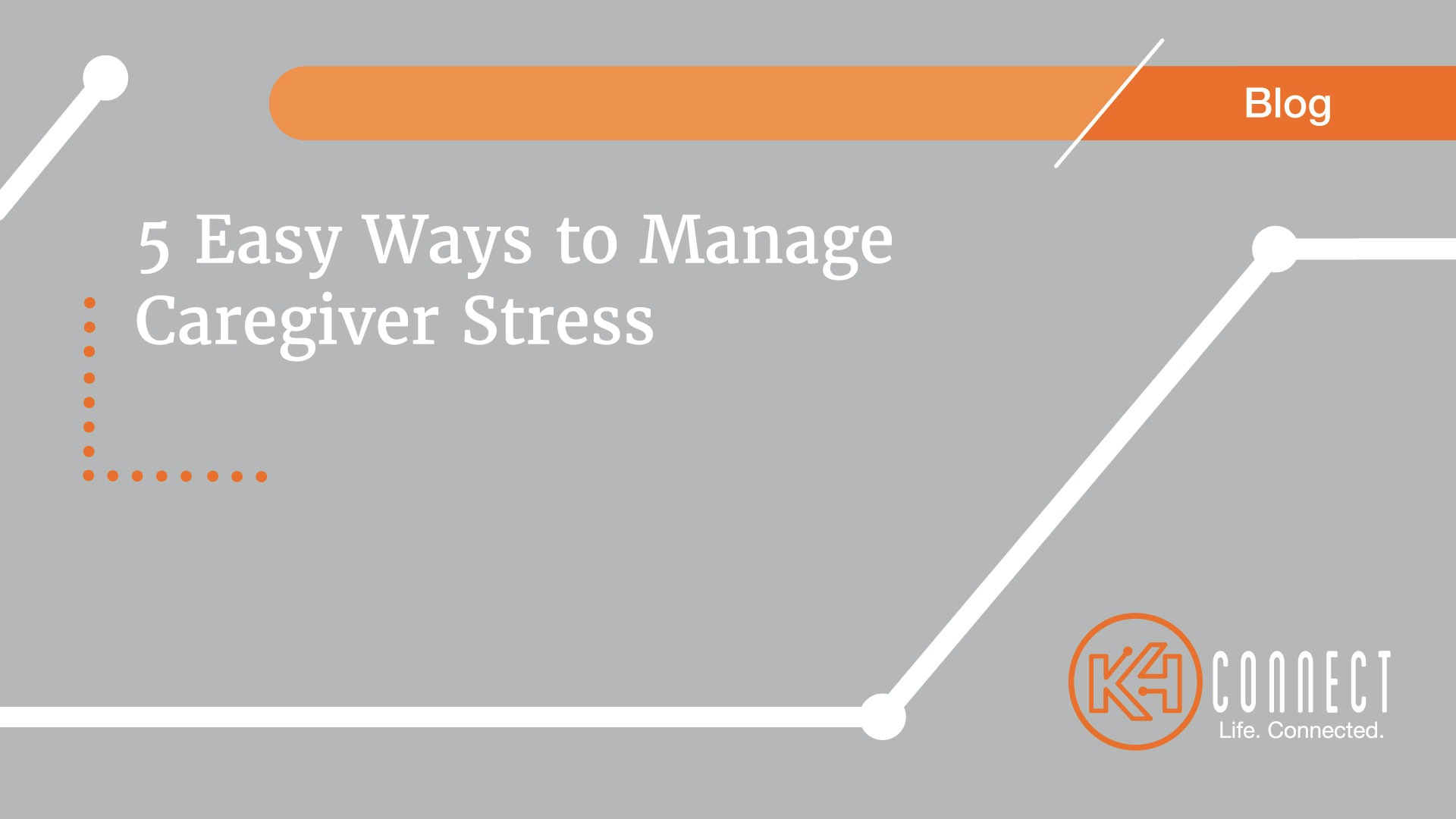As we continue to develop our products, finding creative and useful ways to help caregivers is something we always consider with each new feature. At K4Connect, our goal is to help family and professional caregivers give their loved ones the best care possible.

By: Diana Gore
Product Manager, K4Connect
November 4, 2018
Being a caregiver is not for the faint of heart, no matter the age of the care recipient. As a mom of twins I experienced the reality of sheer exhaustion and the stress that comes with two babies. And a few years later I discovered another level of stress that came with two toddlers and a new baby in our home. Just as caring for young children adds a new dimension of stress to life, so does caring for an aging loved one. Luckily, there is a massive new wave of caregiving resources being developed as baby boomers age.
As a product manager at K4Connect, I work daily to understand how the technology we create can help improve the lives of seniors and those that care for them. As a company we believe that tech can make the lives of seniors and those that care for them simpler, healthier and happier. Our first product, K4Community, includes communication tools that help families stay connected through voice, text and video chatting which can help provide caregivers peace of mind about their loved one. In addition to improved communication, there are a bevy of low-cost (or free) tech tools that can help ease your mind and lift your spirits.
According to the 2015 National Alliance for Caregiving/AARP Caregiving in America report, about 34.2 million Americans provided unpaid care to an adult age 50 or older over a 12 month period. Almost half of all family caregivers reported being “somewhat stressed” and more than a third reported being “highly stressed”meaning that if you’re experiencing this, you’re not alone! Being the caregiver of an aging loved one can be rewarding but also comes with challenges, many of which can affect your own health.
Paid, professional caregivers are also not immune to the stress that comes from caregiving. The PHI Workforce Data Center sites that in 2016 there were almost 4.5 million direct care workers providing hands on care in the United States. These paid caregivers often work long shifts and have physically, mentally and emotionally demanding roles. The American Psychology Association’s 2014 Stress Statistics list job pressure as the number two cause of stress, just behind money. Implementing ways to reduce stress for direct care workers can improve morale and job satisfaction.
Caregivers must care for themselves so they can in turn care for others. Paid or unpaid, caregiving is a challenging role and finding ways to reduce stress is critical to maintaining the caregivers overall health. Stress can be a constant companion when you are a caregiver but it doesn’t have to be.
Here are 5 ways to reduce caregiver stress:
1. Laugh
A good laugh can help relieve built up stress and improve your mood. By following sites like Reader’s Digest’s Funny Jokes on social media, you can get your daily dose of laughter just by scrolling Facebook. Here’s a sample of what you might see:
Why aren’t koalas actually bears?
- They don’t meet the koalafications.
What does a pepper do when it’s angry?
- It gets jalapeño face!
As a scarecrow, people say I’m outstanding in my field.
- But hay, it’s in my jeans.
Laughter really can be a great medicine! A 2014 study conducted at Loma Linda University showed that humor can have clinical benefits and help support whole-person wellness.
The Mayo Clinic states that laughter has the following short-term health benefits:
Stimulate many organs. Laughter enhances your intake of oxygen-rich air, stimulates your heart, lungs and muscles, and increases the endorphins that are released by your brain:
Activate and relieve your stress response. A rollicking laugh fires up and then cools down your stress response, and it can increase your heart rate and blood pressure. The result? A good, relaxed feeling.
Soothe tension. Laughter can also stimulate circulation and aid muscle relaxation, both of which can help reduce some of the physical symptoms of stress. It’s hard to feel anxious or tense when you have a big smile on your face.
Read the comics, watch a comedy show, search for funny video clips online, call or text a friend who makes you laugh, download some of these funny apps or check out this site for some more good clean jokes!
2. Take a break
Grab a quick 5 minute walk, linger at the water fountain or sink and sip your water, scroll through some pictures on your phone or tablet, listen to one of your favorite songs, play with a pet, sit in your car an visualize yourself in a place that is peaceful or jump online and visit the Calm website or use the Calm free mobile app (available for both iPhone and Android for quick stress reduction.
Giving yourself a few minutes throughout your day to take a break and regroup will give you the boost you need to continue to stay focused and energized as a caregiver.
3. Practice Breathing Techniques
A highly effective way to relieve stress is to use focused breathing techniques that encourage slow, deep breaths. You can start by simply taking a slow deep breath in through your nose and breathe out gradually through your mouth (try to make the exhale take twice as long as the inhale), repeat 3-4 times. Other recommended breathing techniques that help reduce stress are belly breathing, 4-7-8 breathing and roll breathing.
There are now several free apps that help guide you through this. Check out these out:
4. Get Up and Move
Exercise releases endorphins, the natural chemicals produced in your body and brain that create a positive feeling in your body, often making you feel pleasure and satisfaction. The positive feeling will leave you feeling less stressed and it doesn’t have to take a lot of time. John Ratey, MD, a Harvard Medical School professor and the author of Spark: The Revolutionary New Science of Exercise and the Brain, says just two minutes of exercise is enough to change your mood if you raise your heart rate. “Anything from squats to jumping jacks supplies a surge of neurotransmitters, such as norepinephrine, dopamine and serotonin – the same targets as antidepressants,” he says.
30 minutes of physical exercise a day is ideal but if you can’t fit 30 minutes straight into your day then break it into three 10 minute intervals. Go on a walk, do some yard work, stretch, jog in place during commercial breaks of your favorite show. Take 10 minutes and do some simple exercises – 10 air squats, 10 jumping jacks, 10 standing push-ups, 10 calf raises and repeat.
Activity trackers can be a great way to motivate you to get up and move around, even when you might not feel like it. It’s such an important part of overall well-being that K4Connect partnered with Garmin to provide fitness trackers to residents in communities using K4Community. This provides them a way to keep track of their wellness and get out and move. You can start tracking your daily exercise and set goals for yourself using activity tracking wearables such as the Garmin Vivofit 3 that is used by K4Community members.
5. Gratitude
This can be a powerful means to combat stress because it reminds you to look for the positives. There are good things in life regardless of how stressful or overwhelming things may seem. Making time to pause and acknowledge things you are grateful for will help shift your perspective and reduce your stress. Not convinced about the importance of gratitude, here are 7 scientifically proven benefits of gratitude.
Here are some simple ways to inject gratitude into your day:
- Keep a paper gratitude journal or check out these gratitude journal apps on iOS or Android.
- Post quotes and images that remind you to be grateful around your house or workplace.
- Surprise someone with an act of kindness.
- Watch an inspiring video that will remind you of the good in the world.
- Send someone a handwritten thank-you note or thank-you email or text.
- Make a donation to an organization you are grateful for.
Unfortunately for caregivers, stress is an inevitable part of the job. With some management and help from technology, there are many ways to help assist in this.
At K4Connect, we don’t have all the answers, but our goal is to help family and professional caregivers use technology to stay cool, calm and collected. As we continue to develop our products, finding creative and useful ways to help caregivers is something we always consider with each new feature.

